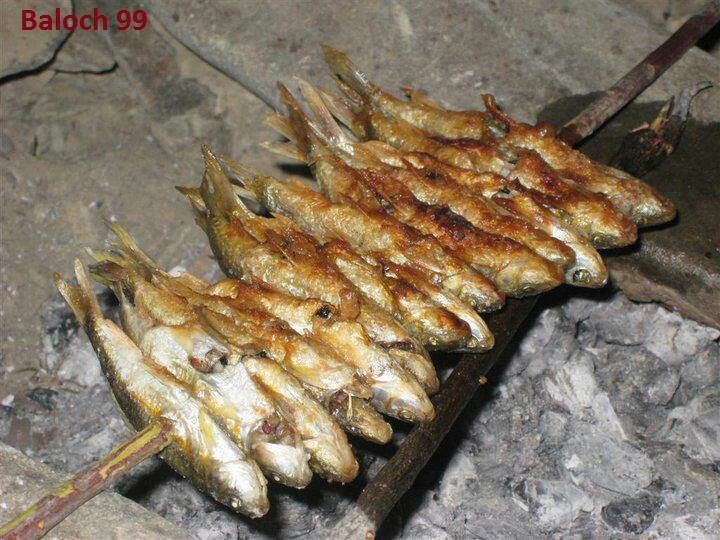Balochi cuisine refers to the food and cuisine of the Baloch people from the Balochistan region, comprising the Balochistan as well as Sistan-o- Balochistan in Iran and some areas of the Afghanistan. Baloch food has a regional variance in contrast to many other cuisines of the region. The Balochi cuisine is known for its richness and flavor and it is not spicy but aromatic. Balochi cuisine, traditional and fast foods are popular in cities and rural areas. Baloch use mild aromatic spices, less oil, characterizing affinities to the cuisines of neighboring Afghanistan, Iran and Central Asia. However, given diversity of the people of Balochistan, cuisines generally differ from home to home and region to region and may be totally different from mainstream Balochi cuisine. Sajji, Mutton Roast, Tabaeeg, Kaak, Kurno, Dampukht, Sheelanch are well-known cuisine, food items and there are a large numbers of meat, rice, vegetable and milk food items consumed everyday basis in Baloch areas. Baloch take three or four meals in day Harzband (breakfast), Nihari, Subarag, Neemroch Nan (Luanch), Nemrozi, Neemroshi (Afternoon) and Sham, Shapenan (dinner).
Sajji is a native dish of the beautiful province of Balochistan, which is popular in Balochi cuisine. It consists of whole lamb, in skewers (fat and meat intact), marinated only in salt, sometimes covered with green papaya paste, stuffed with rice, then roasted over coals. Sajji is considered done when it is at the ‘rare’ stage. It is served with special bread “Kaak”, “roti” or “naan”, which is baked in an oven, wrapped around a stone “tandoor”. Sajji is native Prominent Baloch dishes such as the lamb-skewed Sajji have gained massive popularity among different parts of country ding the food hubs.
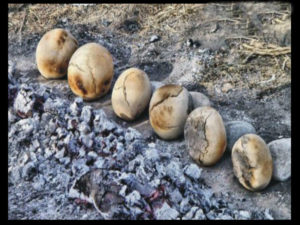
Tabaeeg also known dried meat is winter food popular in Balochistan, it also called Tabaeeg and Patav by the Balochs and Parsanda and Landhi by Pashtuns. The use of Khadit, a kind of biltong, is common among the well-to-do classes and also some poorer people in the different cool areas. It generally made of mutton, but occasionally also of goat’s meat, beef and camel’s flesh, and is pickled in a mixture of salt and asafetida, cut into strips and dried in the sun. Consumption of khadit is common in during winters. Sheep’s especially fattened for the so that there flash may be more suitable for preparing Khadit. It consumed only in summers in freezing weather areas of Balochistan. Khadit-o-pati (cooking of Khadit with mung pulse) Khaddi Kabbab is a dish in which Balochistan is cook a whole lamb or goat on fire. Usually there is raw rice in the stomach of the lamb and the rice is cooked by the fats of the lamb. The lamb is cooked on fire.
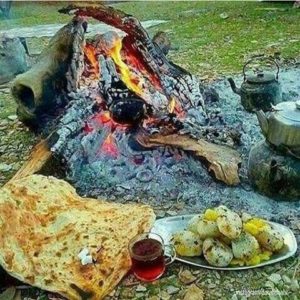 Vegetable so many wild and cultivated in Balochistan and which are used as food items and dishes in Baloch society, saag (leaf-based dishes of spinach, mustard leaf, Basella, and other wild plants) i.e. Kulkusht (colocynth), Mager (Rumex vesicarious) Kalhook, Malera, Lulur, Palak (Spinalla) , Saresaag (Mustard leaves) , Goleef, Potronkesaag, Aptak( which grows after rain at the roots of dwarf-palm) , Chapli, Teripanko, Ziban-e-Burak, Gurbust (whitetop), Gandgo, Kaleer (capper), Sandae, Peemalo, mallai, makhankur, chambark, sochanko, Aaluko, guragpad (Malva parviflora), indargah (Trianthema pentandra), Bhuri, which is prepared from the pollen of the Kul plant (Typha sngustifolia), the bhuri is then either eaten as it or mixed with sugar is which case the preparation is known as Shoragh.
Vegetable so many wild and cultivated in Balochistan and which are used as food items and dishes in Baloch society, saag (leaf-based dishes of spinach, mustard leaf, Basella, and other wild plants) i.e. Kulkusht (colocynth), Mager (Rumex vesicarious) Kalhook, Malera, Lulur, Palak (Spinalla) , Saresaag (Mustard leaves) , Goleef, Potronkesaag, Aptak( which grows after rain at the roots of dwarf-palm) , Chapli, Teripanko, Ziban-e-Burak, Gurbust (whitetop), Gandgo, Kaleer (capper), Sandae, Peemalo, mallai, makhankur, chambark, sochanko, Aaluko, guragpad (Malva parviflora), indargah (Trianthema pentandra), Bhuri, which is prepared from the pollen of the Kul plant (Typha sngustifolia), the bhuri is then either eaten as it or mixed with sugar is which case the preparation is known as Shoragh.
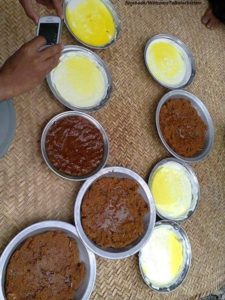
Sheelanch/ Quroot, also called Kashk (Iran) is a reconstituted Quroot product. It was traditionally a by-product of butter made from sheep or goat milk. The residual buttermilk remaining after churning of the butter is soured further by keeping at room temperature for a few days, treated with salt, and then boiled. The precipitated casein is filtered by cheesecloth, pressed to remove liquid, and shaped into balls. The product is thus a very sour cottage cheese.
Rice dishes are the “king” of all foods in the parts of the Balochistan. The Baloch have certainly taken much time and effort in creating their rice dishes, as they are considered the best part of any meal. Wealthier families will eat one rice dish per day. Weddings and family gatherings must feature several rice dishes and certainly reputations can be made in the realm of rice preparation. Rice is also cooked with meat & stock, vegetables, wild plants, pulses and others Gaun, Nagez Morswabi, Taren Banklenk, Maak, Mash, Dalag, Sabzak, Bat-o-Mahi and many others.
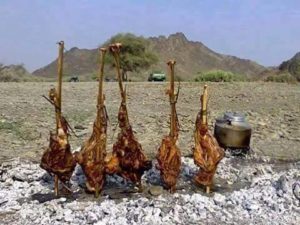 Naan (Bread) Kaak, and Kurno a rock-hard prepared bread, is also a notable dish ( which is made by wrapping dough round a hot stone and putting it on the embers, Popular among the nomadic Balochis, Kaak is very hard once it has been baked) other breads prepared in Baloch area are Zurat or Juhri Naan (sorghum bread), Punari Naan (flour, salt and khameer mixed and baked on caol) , Dotapagi Naan ( part of two stone collected and make them hot and lay the wet flour on one and keep other upon it), Tapag-e-Naan ( thrown dough on skillet and half bake and half bake on caols) , Shurdi Naan ( half-baked bread mixed with ghee), Tandoori Naan ( Bread is cooked in a tandoor, from which tandoori cooking takes its name), Teni Naan, Chaputi Naan (Chapatis are made from a firm dough made from flour and water. Some people also add salt and/or oil to the dough. Small portions of the dough are rolled out into discs much like a tortilla, using a rolling pin. The rolled-out dough is thrown on the preheated dry skillet and cooked on both sides. In some regions it is only partly cooked on the skillet, and then put directly on a high flame, which makes it blow up like a balloon), Barinji Naan (Rice flour bread), Seesark, Shusti/Dodoki/Dako-e-Naan (flour, sugar, ghee mixed bread), Barzan-e-Naan (pearl millet flour bread) , Saag-e-Naan/ Potronk-e-Naan/ Potronk-e-saag-e-Naan/Gomadran-e-Naan (leaf base of mustard and other wild plants and flour bread), Banklenk-e-Naan (broad bean/ fava bean and flour bread) etc.
Naan (Bread) Kaak, and Kurno a rock-hard prepared bread, is also a notable dish ( which is made by wrapping dough round a hot stone and putting it on the embers, Popular among the nomadic Balochis, Kaak is very hard once it has been baked) other breads prepared in Baloch area are Zurat or Juhri Naan (sorghum bread), Punari Naan (flour, salt and khameer mixed and baked on caol) , Dotapagi Naan ( part of two stone collected and make them hot and lay the wet flour on one and keep other upon it), Tapag-e-Naan ( thrown dough on skillet and half bake and half bake on caols) , Shurdi Naan ( half-baked bread mixed with ghee), Tandoori Naan ( Bread is cooked in a tandoor, from which tandoori cooking takes its name), Teni Naan, Chaputi Naan (Chapatis are made from a firm dough made from flour and water. Some people also add salt and/or oil to the dough. Small portions of the dough are rolled out into discs much like a tortilla, using a rolling pin. The rolled-out dough is thrown on the preheated dry skillet and cooked on both sides. In some regions it is only partly cooked on the skillet, and then put directly on a high flame, which makes it blow up like a balloon), Barinji Naan (Rice flour bread), Seesark, Shusti/Dodoki/Dako-e-Naan (flour, sugar, ghee mixed bread), Barzan-e-Naan (pearl millet flour bread) , Saag-e-Naan/ Potronk-e-Naan/ Potronk-e-saag-e-Naan/Gomadran-e-Naan (leaf base of mustard and other wild plants and flour bread), Banklenk-e-Naan (broad bean/ fava bean and flour bread) etc.
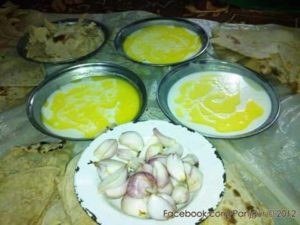 Wad-o-Aap (Soup of Salt and Water boiling with some items due to non-availability of all required indigents of a dish but it provides full and unique taste) another traditional foods mostly consumed in Baloch Society i.e Sheelanch-e-wad-o-aap (Sheelanch, onion, pickle, salt, black pepper & water), Mahi-e-wad-o-aap( fish, onion, pickle, salt, black pepper & water) , Seerak-e-Wad-o-Aap (Garlic, onion, pickle, salt, black pepper & water),, Gozhd-e-Wad-o-Aap (Meat, onion, pickle, salt, black pepper & water),, Guren Wad-o-Aap ( onion, pickle, salt, black pepper & water),, Imli-e-Wad-o-Aap (Tamarind, Gurr (Local made sugar), Dan chob, water), Tamoter-e-Wad-o-Aap ( Tamoto, Tamarind, Gurr (Local made sugar), water) , Thehrzko (onion, black pepper), Zereg-e-Wad-o-Aap (cumin, Ghee) , Sher-o-Rughan ( Ghee, Sheer (Yogurt based drink) onion and bread) , Aah Sheerag ( Pickle, salt, onion).
Wad-o-Aap (Soup of Salt and Water boiling with some items due to non-availability of all required indigents of a dish but it provides full and unique taste) another traditional foods mostly consumed in Baloch Society i.e Sheelanch-e-wad-o-aap (Sheelanch, onion, pickle, salt, black pepper & water), Mahi-e-wad-o-aap( fish, onion, pickle, salt, black pepper & water) , Seerak-e-Wad-o-Aap (Garlic, onion, pickle, salt, black pepper & water),, Gozhd-e-Wad-o-Aap (Meat, onion, pickle, salt, black pepper & water),, Guren Wad-o-Aap ( onion, pickle, salt, black pepper & water),, Imli-e-Wad-o-Aap (Tamarind, Gurr (Local made sugar), Dan chob, water), Tamoter-e-Wad-o-Aap ( Tamoto, Tamarind, Gurr (Local made sugar), water) , Thehrzko (onion, black pepper), Zereg-e-Wad-o-Aap (cumin, Ghee) , Sher-o-Rughan ( Ghee, Sheer (Yogurt based drink) onion and bread) , Aah Sheerag ( Pickle, salt, onion).
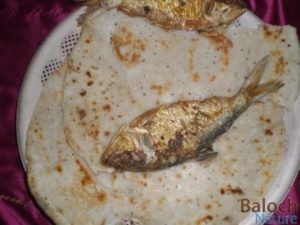 Mixed foods also items used in Baloch society like Achar (consists of onion, garlic, chilie,s coriander, pomegranate seeds, with flour and made into small pieces), , Kashak (flour Sheer (Yogurt based drink), onion ), , Sheelanch (Sheer “Yogurt based drink” and cloth) , Tabahag (dried meat, pomegranate seeds), Chezhak, Panir (Panirbaad, Sheer “Yogurt based drink” and cloth), Sapan Rughan (Sheer, Turmeric) , Koel (dried bean, cickpea, rice, salt, dal, wheat grain ant water), , Kosh (wild plant boiled in water mix sheer and date) , Hushken Banklenk ( dried bean), gwatuk (wild plant boiled and mix sheer), Mahi Chug (flour, ghee, sugar), Mader (date, ghee and flour) , Pisht or lot ( a porridge made of half-parched barley flour, is considered delicacy) , Lehdi/ Balad (flour, sugar, ghee), Arat Halwa (flour, sugar, ghee, dry fruit and water), Mosh, Gaonpos (date without seed), Pondi (flour, date), Shalgami (Turnip, date, water), Gazurki (carrot, date and water), Tasaapi (Sugar and black pepper), Zaraap (date, Gurr, chili, ghee and flour), Changal/Bibi ( flour and date) Dasti Hoshejosh (grain, sugar, ghee and water), Treit/Kutti (curry and bread), Aputak ( wild plant, ghee, spice and salt), Sharshko (wild plant, rice, ghee, onion, tomato, green chili), Chapli Gosht ( meat, salt, green chili, spice, garlic, tomato), Sheelanch-o-wanger (prepare brinjal and mix sheelanch) Tejaki Chamri (dried melon) Chauli (,Melon pulp is dried and preserved and eaten with powder made by pounding on seeds), Pato ( melon seeds are parched with a little salt), Nageezmorsawabi (Mash bean or kidney bean, mung bean, green chili, ghee, spice, pomegranate seed, dry pickle) etc. A large number of Balochi people living on the coastal belt eat fish in their own style.
Mixed foods also items used in Baloch society like Achar (consists of onion, garlic, chilie,s coriander, pomegranate seeds, with flour and made into small pieces), , Kashak (flour Sheer (Yogurt based drink), onion ), , Sheelanch (Sheer “Yogurt based drink” and cloth) , Tabahag (dried meat, pomegranate seeds), Chezhak, Panir (Panirbaad, Sheer “Yogurt based drink” and cloth), Sapan Rughan (Sheer, Turmeric) , Koel (dried bean, cickpea, rice, salt, dal, wheat grain ant water), , Kosh (wild plant boiled in water mix sheer and date) , Hushken Banklenk ( dried bean), gwatuk (wild plant boiled and mix sheer), Mahi Chug (flour, ghee, sugar), Mader (date, ghee and flour) , Pisht or lot ( a porridge made of half-parched barley flour, is considered delicacy) , Lehdi/ Balad (flour, sugar, ghee), Arat Halwa (flour, sugar, ghee, dry fruit and water), Mosh, Gaonpos (date without seed), Pondi (flour, date), Shalgami (Turnip, date, water), Gazurki (carrot, date and water), Tasaapi (Sugar and black pepper), Zaraap (date, Gurr, chili, ghee and flour), Changal/Bibi ( flour and date) Dasti Hoshejosh (grain, sugar, ghee and water), Treit/Kutti (curry and bread), Aputak ( wild plant, ghee, spice and salt), Sharshko (wild plant, rice, ghee, onion, tomato, green chili), Chapli Gosht ( meat, salt, green chili, spice, garlic, tomato), Sheelanch-o-wanger (prepare brinjal and mix sheelanch) Tejaki Chamri (dried melon) Chauli (,Melon pulp is dried and preserved and eaten with powder made by pounding on seeds), Pato ( melon seeds are parched with a little salt), Nageezmorsawabi (Mash bean or kidney bean, mung bean, green chili, ghee, spice, pomegranate seed, dry pickle) etc. A large number of Balochi people living on the coastal belt eat fish in their own style.

